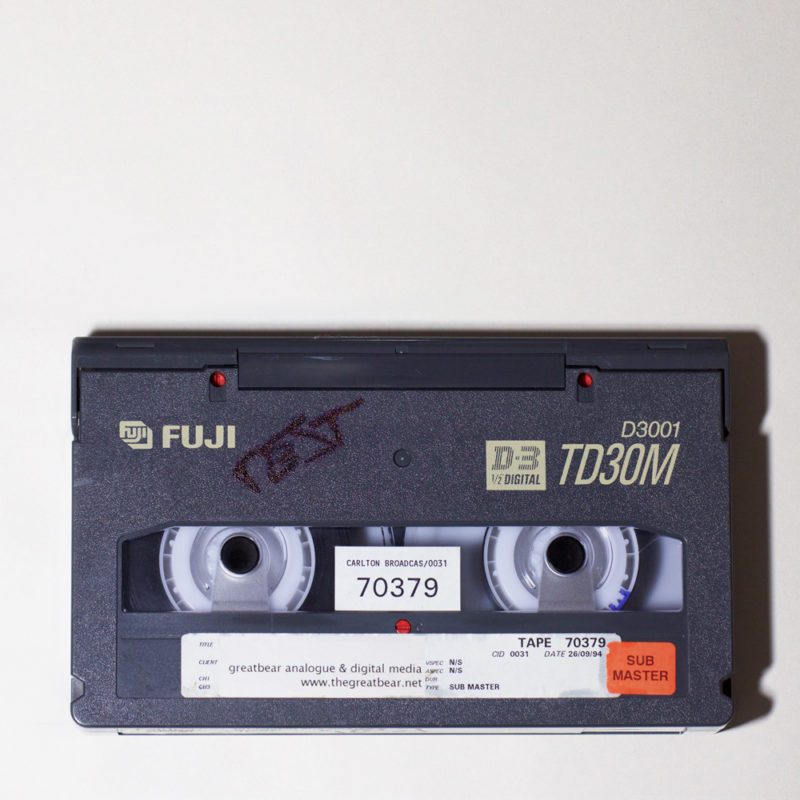introduction to D-3 & D-5 video cassette transfer
At Greatbear we transfer D-3, D-5 and D-5HD digital video tape. D-3 is an uncompressed composite digital videocassette format introduced commercially by Panasonic in 1991 to compete with Ampex's D-2. The D-3 format used ½" metal particle tape for recording PAL or NTSC signals sampled at 8 bits. The D-5 format (Panasonic 1994) used the same cassette as D-3 but recorded component signals sampled to CCIR 601 recommendations at 10-bit resolution (a development of Sony's D-1 format). D-5HD is the compressed HD-compatible version of D-5.
We offer a range of delivery formats for our video transfers. Following International Association of Sound and Audiovisual Archives TC-06 guidelines, we deliver FFV1 lossless files or 10-bit uncompressed video files in .mkv or .mov containers for archives. We can also produce Apple ProRes mezzanine files for ease of editing. We provide smaller viewing files as H.264 encoded .mp4 files or on DVD. We're happy to create any other digital video files, according to your needs.
We can provide the appropriately-sized USB delivery media for your files, or use media supplied by you, or deliver your files online. Files delivered on hard drive can be for any operating system MacOS, Windows or GNU/Linux and filesystems (HFS+, NTFS or EXT3).
D-3, D-5 and D-5HD video cassette recordings can vary both in duration and in the extent of physical tape degradation, so we always assess tapes before confirming the price of a transfer.
We offer free assessments - please contact us to discuss your project.
For an introduction to our assessment and treatment processes, please see our guide to "what happens to your video tape".
D-3 & D-5 video machines
The D-3 lossless composite digital video tape recorders made by Panasonic in the early '90s are rare now in the UK and have very little spares backup for key parts such as head drums. This rarity is in part due to the BBC's past heavy use of them and need for machines for their D-3 preservation project shown in the video below.
We have 4 working D-3 machines all with low head hours, so are in an excellent position long-term for preserving collections on this format.
Pansonic D-5 and D-5 HD are developments using the same 1/2" tape format of D-3 but recording a 10-bit uncompressed component digital video signal, and in its final incarnation component HD, in multiple standards.
Our machines include:
- Panasonic AJ-D350E / JVC PR-D1000E
- Panasonic AJ-HD3700A
D-3 & D-5 format variation
| video standard | D3 capture supported | D5 capture supported | D5 HD capture supported | preservation of LTC & VITC timecode supported |
|---|---|---|---|---|
| PAL | ✓ | ✓ | ✓ | ✓ |
| NTSC | ✓ | ✓ | ✓ | ✓ |
D-3 & D-5 video tape risks & vulnerabilities
In 2013 the BBC had thousands of D-3 recordings in its archive and had a large scale but difficult preservation project due to the fragility of the D-3 tapes and the obsolescence of the VTRs. Richard Wright from http://preservationguide.co.uk has commented earlier in 2019 on this site that:
The 100k D3 tapes were all that were necessary to transfer. One large chunk of D3s were copies (two or more D3s of the same programme), and another large chunk were redundant, from the years when digitisation of analogue formats had a mixed economy, and produced one D3 and one digibeta. A third small chunk were D3s that were deselected: they didn't belong in the permanent archive (2nd versions of programmes cut for US sales, for example).
The BBC even made a short video about this project that can be viewed below:
D-3 & D-5 video recording history
The ½ inch cassette size of D-3 allowed a full family of VTR equipment to be realised in one format, including a camcorder. In addition to the D-3 format's popularity with the BBC, Panasonic equipped more than 20 rights-holding broadcast organisations from around the world with D-3 and D-5 digital broadcast video equipment for the 1996 Olympic Games.
Read our blog article: D-1, D-2 & D-3: histories of digital video tape
